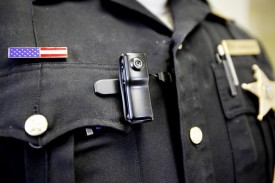San Diego Cops Keep Forgetting to Turn Their Body Cameras On Before Killing Peopleby William Norman GriggNov. 05, 2015 |
Popular 
Report: Blinken Sitting On Staff Recommendations to Sanction Israeli Military Units Linked to Killings or Rapes

America Last: House Bill Provides $26B for Israel, $61B for Ukraine and Zero to Secure U.S. Border

Bari Weiss' Free Speech Martyr Uri Berliner Wants FBI and Police to Spy on Pro-Palestine Activists

'Woke' Google Fires 28 Employees Who Protested Gaza Genocide

John Hagee Cheers Israel-Iran Battle as 'Gog and Magog War,' Will Lobby Congress Not to Deescalate
  San Diego, CA — All patrol officers employed by the San Diego Police Department are now required to carry body cameras -- but they avoid falling prey to the dreaded "YouTube Effect" by simply refusing to activate them when they could be of greatest use. San Diego, CA — All patrol officers employed by the San Diego Police Department are now required to carry body cameras -- but they avoid falling prey to the dreaded "YouTube Effect" by simply refusing to activate them when they could be of greatest use. On two occasions during the past six months, police officers in San Diego have "failed" to activate their body cameras during incidents that eventually led to lethal force. This has led the department to revise its policy to require officers to activate their cameras "before traffic stops, field interviews, detentions, arrests, and any other `enforcement related contacts' -- as long as it's safe to do so," reports the San Diego Union Tribune. The "safety" exception, however, offers wide latitude for officers to avoid recording potentially lethal encounters. The department has now asked the company that manufactures the hardware "to see if technology exists that would automatically turn on an officer's body-worn camera when they draw their gun from its holster." That request offers a powerful, if tacit, indictment of the discipline and professionalism of the San Diego PD's rank and file. The department's track record suggests that the request might have been made for purposes of public relations, rather than an honest effort to improve institutional transparency. In early 2014, the SDPD purchased several hundred body cameras. This was done, according to former Chief William Lansdowne, in the hope that it "helps us with misunderstandings, and with lawsuits." Initially, 100 cameras were purchased at a cost of $200,000. When Shelly Zimmerman took over as Chief in March of that year, she expanded the program to include every officer in the department. This prompted predictable push-back from the San Diego Police Officers Association, which complained that the proposal imperiled officer "privacy." "Everybody is jumping on the bandwagon thinking this is going to be some sort of panacea and [will] solve all these problems when the reality is, it may create more," groused SDPOA President Brian Marvel. The program was fully implemented by October 2014, at which time Chief Zimmerman promised that video from body cameras would not be easily accessible, and that they would be removed from storage after six months in the absence of a court case or a specific citizen complaint. This statement appeared to prioritize the concerns of officers above those of the public supposedly served by them -- and considerations of officer "privacy" might help explain why cameras weren't activated during two recent lethal force incidents. Last April, Officer Neal Browder fatally shot a 31-year-old man named Fridoon Zalbeg Rawshannehad, who had been suspected of carrying a knife. After the shooting, no weapon was found, although Rawshannehad was carrying what has been described as "a shiny looking object." This fatal confrontation should have been captured on body cam video. However, Officer Bowder's camera either wasn't activated or was defective. Video was obtained from a nearby security camera, but has not been released to the public while the department investigates the shooting. Last month, two San Diego PD officers fatally shot a 39-year-old man who reportedly ran into traffic and caused a disturbance. The man was shot three times after allegedly pointing a pistol at the officers. Neither of the officers involved in the shooting activated his body camera. As of September, 871 SDPD officers were outfitted with body cameras. According to a report compiled by the department, since the program was implemented complaints against officers fell 23 percent, and misconduct allegations by 44 percent, during the first year that the cameras were available. During the same period, interestingly, use of force episodes had increased by ten percent. Incidents of "greater" force -- which involve an officer employing tasers, pepper spray, or choke holds -- dropped by eight percent after the body cams were distributed. Perhaps most significantly, the number of non-sustained misconduct allegations dropped from 19 to 3 -- which suggests the value of the technology as a way of enhancing officer accountability. It should be pointed out that the department's report on body camera use dealt with only three of its divisions. Also noteworthy is the fact that since July 2014, when the Justice Department began investigating alleged corruption and misconduct within the SDPD -- including four officers accused of sexual assault on-duty, two on-duty DUIs, and three attempted cover-ups within the agency — 110 officers have resigned from the force. External scrutiny of the department may have induced a small but significant exodus of habitual offenders -- but the agency is still doggedly obstructionist. During a discussion "of when she would release body camera evidence ... Zimmerman made an eyebrow-raising observation," observed the Union-Tribune in a house editorial. "She said that to preserve due process rights for accused individuals, she would withhold evidence from public review not just if a criminal investigation were underway but if there were the possibility of related civil litigation." That second caveat, of course, "gives police an infinitely elastic rationale for keeping information from the public." The ACLU complains that the SDPD continues to provide "figures that tell the story they want to tell -- and limit the public's ability to get a full picture of what's happening." That institutional problem cannot be corrected through technology. While police remain accountability-averse, body camera technology isn't a panacea -- it's more of a placebo. |



